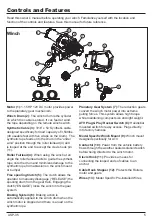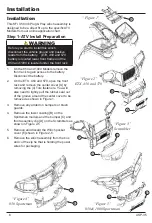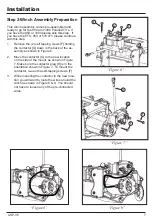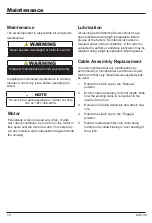
19
ASP-35
Sharp edges and rough surfaces will shorten cable life. Inspect the cable and protective
sleeve before use. Replace cable immediately if the cable has cut strands, fused or melted
fibers, odd stiff sections, chemical contaminated, flat areas or lumps that cannot be eliminated
after flexing the cable.
DANGER
Do not tie the cable to secure a load or connect a broken cable. Do not expose the cable to
chemicals or heat sources. Do not run the cable over sharp edges or rough surfaces.
WARNING
Synthetic Winch Cable Inspection:
•
The cable will have a smooth finish when new (A).
•
The outer surface of the cable will appear slightly fuzzy
(B) after normal use. This fuzziness is normal and will
help protect the fibers below.
•
Once approximately 25% of the outer fibers show wear
(C) it must be replaced.
•
Inspect the inner and outer fibers. To inspect the inner
fibers, open the strands of the cable by compressing the
cable (D) and look for powdered fiber or abrasion (sign
of internal wear). Consider the amount of wear on the
internal fibers when determining the percent of wear for
replacement.
•
Glossy or glazed sections in the cable (E) are usually
caused by compression from the cable being wound on
the winch drum or through a pulley block. This is usually
considered normal.
•
A sign of heat damage is when you compress (D) the
glazed section (E) of the cable and it remains hardened.
In this case the cable must be replaced.
Prolonging the life of your synthetic
cable:
Exercising proper care to prolonging the life of your cable is
your responsibility
1. Minimize Cable Abrasion. Use the supplied protective
sheath when the cable comes in contact with trees, rocks
or other sharp abrasive objects. This sheath is designed
to stay in position while the cable slips through it during use.
2. Keep the Cable Clean. Keep your cable clean as dirt, sand and debris will cause abrasion. Use
the protective sheath to cover the cable on the spool once cable is in the stowed position.
3. Avoid Sharp Bends. If cable is angled at sharp degrees it will decrease the strength of the cable
under load and can cause cable damage or failure.
4. Correct Spool winding. When re-spooling cable without load it is always better to have someone
apply load to the line while you reel it in evenly. Respool the cable evenly and tightly on the drum.
If cable is wound loosely it may cause the cable to work its way down to the drum and wedge itself
under other layers.
5. DO NOT grease or oil the cable.
Synthetic Cable
(A)
(B)
(C)
(D)
(E)





























